Entire Encapsulation of Thymopentin by Extended Biphen[3]arene Carboxylate for Improving Plasma Stability
Abstract
1. Introduction
2. Results and Discussion
3. Conclusions
Author Contributions
Funding
Institutional Review Board Statement
Informed Consent Statement
Data Availability Statement
Conflicts of Interest
References
- Camilli, A.; Bassler, B.L. Bacterial small-molecule signaling pathways. Science 2006, 311, 1113–1116. [Google Scholar] [CrossRef] [PubMed]
- Takamatsu, S.; Ohashi, Y.; Onoue, N.; Tajima, Y.; Lmamichi, T.; Yonezawa, S.; Morimoto, K.; Onouchi, H.; Yamashita, Y. Reverse genetics-based biochemical studies of the ribosomal exit tunnel constriction region in eukaryotic ribosome stalling: Spatial allocation of the regulatory nascent peptide at the constriction. Nucleic Acids Res. 2020, 48, 1985–1999. [Google Scholar] [CrossRef] [PubMed]
- Hou, Y.-T.; Lin, B.; Xu, T.-Y.; Jiang, J.; Luo, S.-L.; Chen, W.-N.; Chen, X.-W.; Wang, Y.-Q.; Liao, G.-R.; Wang, J.-P.; et al. The neurotransmitter calcitonin gene-related peptide shapes an immunosuppressive microenvironment in medullary thyroid cancer. Nat. Commun. 2024, 15, 5555. [Google Scholar] [CrossRef] [PubMed]
- Date, Y.; Ueta, Y.; Yamashita, H.; Matsukura, S.; Kangawa, K.; Sakurai, T.; Yanagisawa, M.; Nakazato, M. Orexins, orexigenic hypothalamic peptides, interact with autonomic, neuroendocrine and neuroregulatory systems. Proc. Natl. Acad. Sci. USA 1999, 96, 748–753. [Google Scholar] [CrossRef]
- Gao, S.; Ghoshal, S.; Zhang, L.-Y.; Stevens, J.R.; McCommis, K.S.; Finck, B.N.; Lopaschuk, G.D.; Butler, A.A. The peptide hormone adropin regulates signal transduction pathways controlling hepatic glucose metabolism in a mouse model of diet-induced obesity. J. Biol. Chem. 2019, 294, 13366–13377. [Google Scholar] [CrossRef]
- Hirakawa, Y.; Sawa, S. Diverse function of plant peptide hormones in local signaling and development. Curr. Opin. Plant. Biol. 2019, 51, 81–87. [Google Scholar] [CrossRef]
- Aggarwal, S.; Huang, E.; Do, H.; Makthal, N.; Li, Y.; Bapteste, E.; Lopez, P.; Bernard, C.; Kumaraswami, M. The leaderless communication peptide (LCP) class of quorum-sensing peptides is broadly distributed among Firmicutes. Nat. Commun. 2023, 14, 5947. [Google Scholar] [CrossRef]
- Kaspar, A.A.; Reichert, J.M. Future directions for peptide therapeutics development. Drug Discov. Today 2013, 18, 807–817. [Google Scholar] [CrossRef]
- Muttenthaler, M.; King, G.F.; Adams, D.J.; Alewood, P.F. Trends in peptide drug discovery. Nat. Rev. Drug Discov. 2021, 20, 309–325. [Google Scholar] [CrossRef]
- Drucker, D.J. Advances in oral peptide therapeutics. Nat. Rev. Drug Discov. 2020, 19, 277–289. [Google Scholar] [CrossRef]
- Matthews, T.; Miklos, S.; Michael, G.; Jain, C.; Ralph, D.M.; Dani, B. Enfuvirtide: The first therapy to inhibit the entry of HIV-1 into host CD4 lymphocytes. Nat. Rev. Drug Discov. 2004, 3, 215–225. [Google Scholar] [CrossRef] [PubMed]
- Fani, M.; Maecke, H.R.; Okarvi, S.M. Radiolabeled peptides: Valuable tools for the detection and treatment of cancer. Theranostics 2012, 2, 481–501. [Google Scholar] [CrossRef] [PubMed]
- Schellenberger, V.; Wang, C.-W.; Geething, N.C.; Spink, B.J.; Campbell, A.; To, W.; Schoole, M.D.; Ying, Y.; Yao, Y.; Bogin, O.; et al. A recombinant polypeptide extends the in vivo half-life of peptides and proteins in a tunable manner. Nat. Biotechnol. 2009, 27, 1186–1190. [Google Scholar] [CrossRef]
- Puente, X.S.; Sánchez, L.M.; Overall, C.M.; López-Otín, C. Human and mouse proteases: A comparative genomic approach. Nat. Rev. Genet. 2003, 4, 544–558. [Google Scholar] [CrossRef]
- Chorev, M.; Shavitz, R.; Goodman, M.; Minick, S.; Guillemin, R. Partially modified retro-inverso-enkephalinamides: Topochemical long-acting analogs in vitro and in vivo. Science 1979, 204, 1210–1212. [Google Scholar] [CrossRef]
- Salveson, P.J.; Moyer, A.P.; Said, M.Y.; Gökçe, G.; Li, X.-T.; Kang, A.; Nguyen, H.; Bera, A.K.; Levine, P.M.; Bhardwaj, G.; et al. Expansive discovery of chemically diverse structured macrocyclic oligoamides. Science 2024, 384, 420–428. [Google Scholar] [CrossRef]
- Wang, C.; Zhang, W.-P.; Xu, L.; Tu, J.-H.; Su, S.; Li, Q.; Zhang, T.; Zheng, L.; Wang, H.; Zhuang, X.-M.; et al. Discovery of a Double-Stapled Short Peptide as a Long-Acting HIV-1 Inactivator with Potential for Oral Bioavailability. J. Med. Chem. 2024, 67, 9991–10004. [Google Scholar] [CrossRef]
- Langer, R.; Folkman, J. Polymers for the sustained release of proteins and other macromolecules. Nature 1976, 263, 797–800. [Google Scholar] [CrossRef]
- Seliktar, D. Designing cell-compatible hydrogels for biomedical applications. Science 2012, 336, 1124–1128. [Google Scholar] [CrossRef]
- Bom, A.; Bradley, M.; Gameron, K.; Clark, J.K.; Egmond, J.V.; Feilden, H.; Maclean, E.J.; Muir, A.W.; Palin, R.; Rees, D.C.; et al. A novel concept of reversing neuromuscular block: Chemical encapsulation of rocuronium bromide by a cyclodextrin-based synthetic host. Angew. Chem. Int. Ed. 2002, 41, 265–270. [Google Scholar] [CrossRef]
- Deng, C.-L.; Murkli, S.L.; Isaacs, L.D. Supramolecular hosts as in vivo sequestration agents for pharmaceuticals and toxins. Chem. Soc. Rev. 2020, 49, 7516–7532. [Google Scholar] [CrossRef] [PubMed]
- Cheng, X.-J.; Liang, L.-L.; Chen, K.; Ji, N.-N.; Xiao, X.; Zhang, J.-X.; Zhang, Y.-Q.; Xue, S.-F.; Zhu, Q.-J.; Ni, X.-L.; et al. Twisted cucurbit[14]uril. Angew. Chem. Int. Ed. 2013, 52, 7252–7255. [Google Scholar] [CrossRef] [PubMed]
- Ikeda, A.; Shinkai, S. Novel cavity design using calix[n]arene skeletons: Toward molecular recognition and metal binding. Chem. Rev. 1997, 97, 1713–1734. [Google Scholar] [CrossRef] [PubMed]
- Hu, X.-B.; Chen, Z.-X.; Chen, L.; Zhang, L.; Hou, J.-L.; Li, Z.-T. Pillar[n]arenes (n = 8-10) with two cavities: Synthesis, structures and complexing properties. Chem. Commun. 2012, 48, 10999–11001. [Google Scholar] [CrossRef]
- Lee, J.W.; Shin, M.H.; Mobley, W.; Urbach, A.R.; Kim, H.I. Supramolecular enhancement of protein analysis via the recognition of phenylalanine with cucurbit[7]uril. J. Am. Chem. Soc. 2015, 137, 15322–15329. [Google Scholar] [CrossRef]
- Li, C.-J.; Ma, J.-W.; Zhao, L.; Zhang, Y.-Y.; Xu, Y.-H.; Shu, X.-Y.; Li, J.; Jia, X.-S. Molecular selective binding of basic amino acids by a water-soluble pillar[5]arene. Chem. Commun. 2013, 49, 1924–1926. [Google Scholar] [CrossRef]
- Chen, L.-M.; Meng, Z.; Tian, L.; Zhang, Y.-H.; Zhao, L.; Du, X.-B.; Ma, M.-K.; Zhang, H.; Chen, J.-Y.; Meng, Q.-B. Complexation of specific residues by carboxylatopillar[6]arene for improving the zymolytic stability of arginine-containing peptides. Org. Biomol. Chem. 2022, 20, 2222–2226. [Google Scholar] [CrossRef]
- Xu, Z.; Jia, S.-R.; Wang, W.; Yuan, Z.; Ravoo, B.J.; Guo, D.-S. Heteromultivalent peptide recognition by co-assembly of cyclodextrin and calixarene amphiphiles enables inhibition of amy-loid fibrillation. Nat. Chem. 2019, 11, 86–93. [Google Scholar] [CrossRef]
- Pan, Y.-C.; Yue, Y.-X.; Hu, X.-Y.; Li, H.-B.; Guo, D.-S. A supramolecular antidote to macromolecular toxins prepared through coassembly of macrocyclic amphiphiles. Adv. Mater. 2021, 33, 2104310. [Google Scholar] [CrossRef]
- Kontos, S.; Hubbell, J.A. Drug development: Longer-lived proteins. Chem. Soc. Rev. 2012, 41, 2686–2695. [Google Scholar] [CrossRef]
- Mitragotri, S.; Burke, P.A.; Langer, R. Overcoming the challenges in administering biopharmaceuticals: Formulation and delivery strategies. Nat. Rev. Drug Discov. 2014, 13, 655–672. [Google Scholar] [CrossRef] [PubMed]
- Malaise, M.G.; Hauwaert, C.; Franchimont, P.; Danneskiold-Samsoe, B.; Bach-Andsersen, R.; Gross, D.; Gerber, H.; Gerschpacher, H.; Stocker, H.; Bolla, K. Treatment of active rheumatoid arthritis with slow intravenous injections of thymopentin. A double-blind placebo-controlled randomised study. Lancet 1985, 11, 832–836. [Google Scholar] [CrossRef] [PubMed]
- Kantharia, B.K.; Goulding, N.J.; Hall, N.D.; Davies, J.; Maddison, P.J.; Bacon, P.A.; Farr, M.; Wojtulewski, J.A.; Englehart, K.M.; Liyanage, S.P.; et al. Thymopentin (TP-5) in the treatment of rheumatoid arthritis. Br. J. Rheumatol. 1989, 28, 118–123. [Google Scholar] [CrossRef] [PubMed]
- Fang, Z.-H.; Zhang, Z.-L.; Wang, R.-T.; Li, S.-H.; Lin, S.-J.; Zhou, Y.-R.; Chen, J.-Y.; Li, C.-J.; Meng, Q.-B. Efficient reversal of neuromuscular blocking agent-induced biological functions and side effects by an extended biphen[3]arene carboxylate. J. Med. Chem. 2024, 67, 21568–21576. [Google Scholar] [CrossRef]
- Tischio, J.P.; Patrick, J.E.; Weintraub, H.S.; Chasin, M.; Goldstrin, G. Short in vitro half-life of thymopoietin32-36 pentapeptide in human plasma. Int. J. Peptide Protein Res. 1979, 14, 479–484. [Google Scholar] [CrossRef]
- Chen, J.-Y.; Meng, Q.-B.; Zhang, Y.-D.; Dong, M.; Zhao, L.; Zhang, Y.-H.; Chen, L.-M.; Chai, Y.; Meng, Z.; Wang, C.-H.; et al. Complexation of an antimicrobial peptide by large-sized macrocycles for decreasing hemolysis and improving stability. Angew. Chem. Int. Ed. 2021, 60, 11288–11293. [Google Scholar] [CrossRef]
- Yao, Y.-H.; Zhang, Y.-M.; Yu, H.-J.; Liu, Y. Cucurbituril-based biomacromolecular assemblies. Angew. Chem. Int. Ed. 2021, 60, 3870–3880. [Google Scholar]
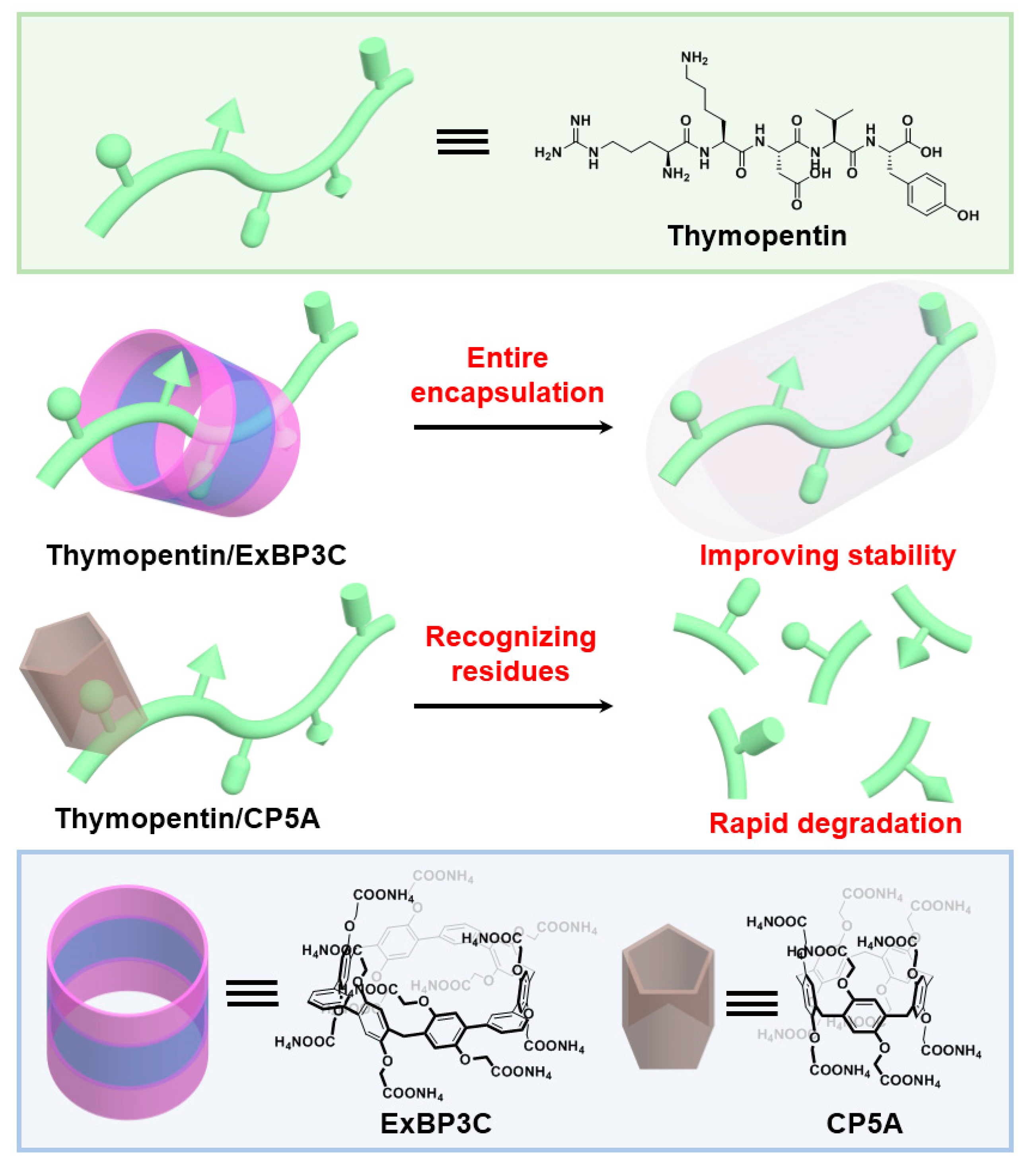
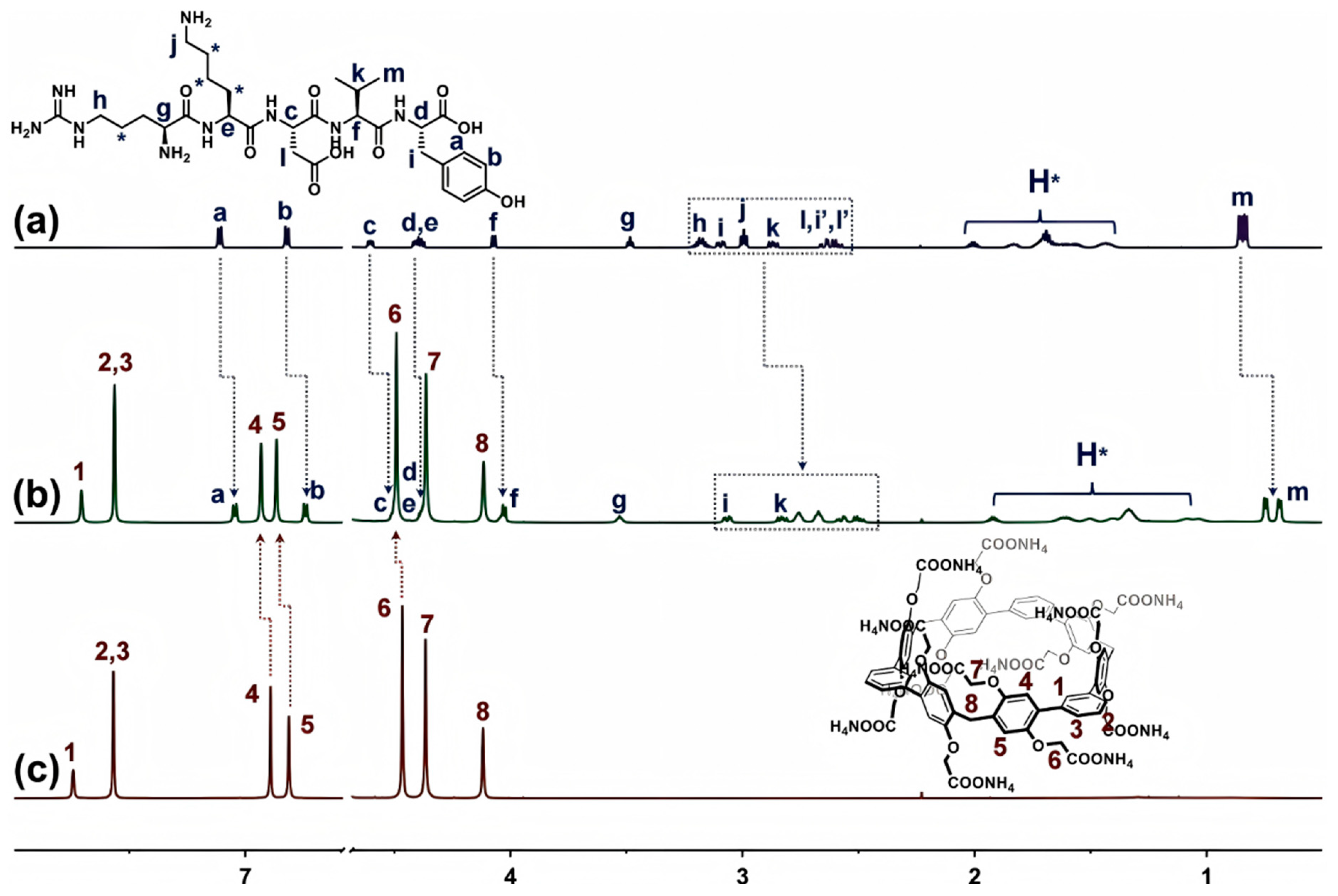

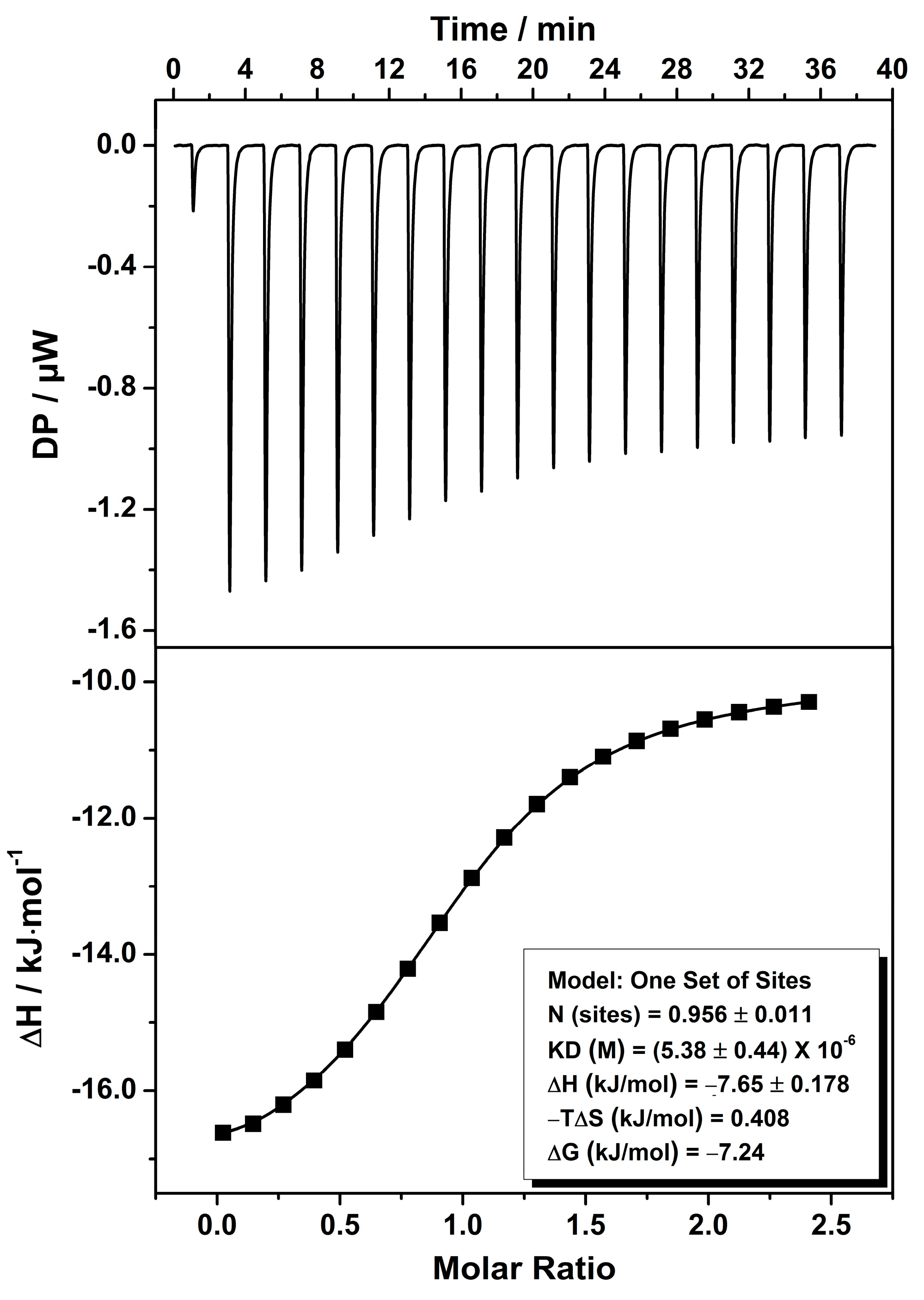
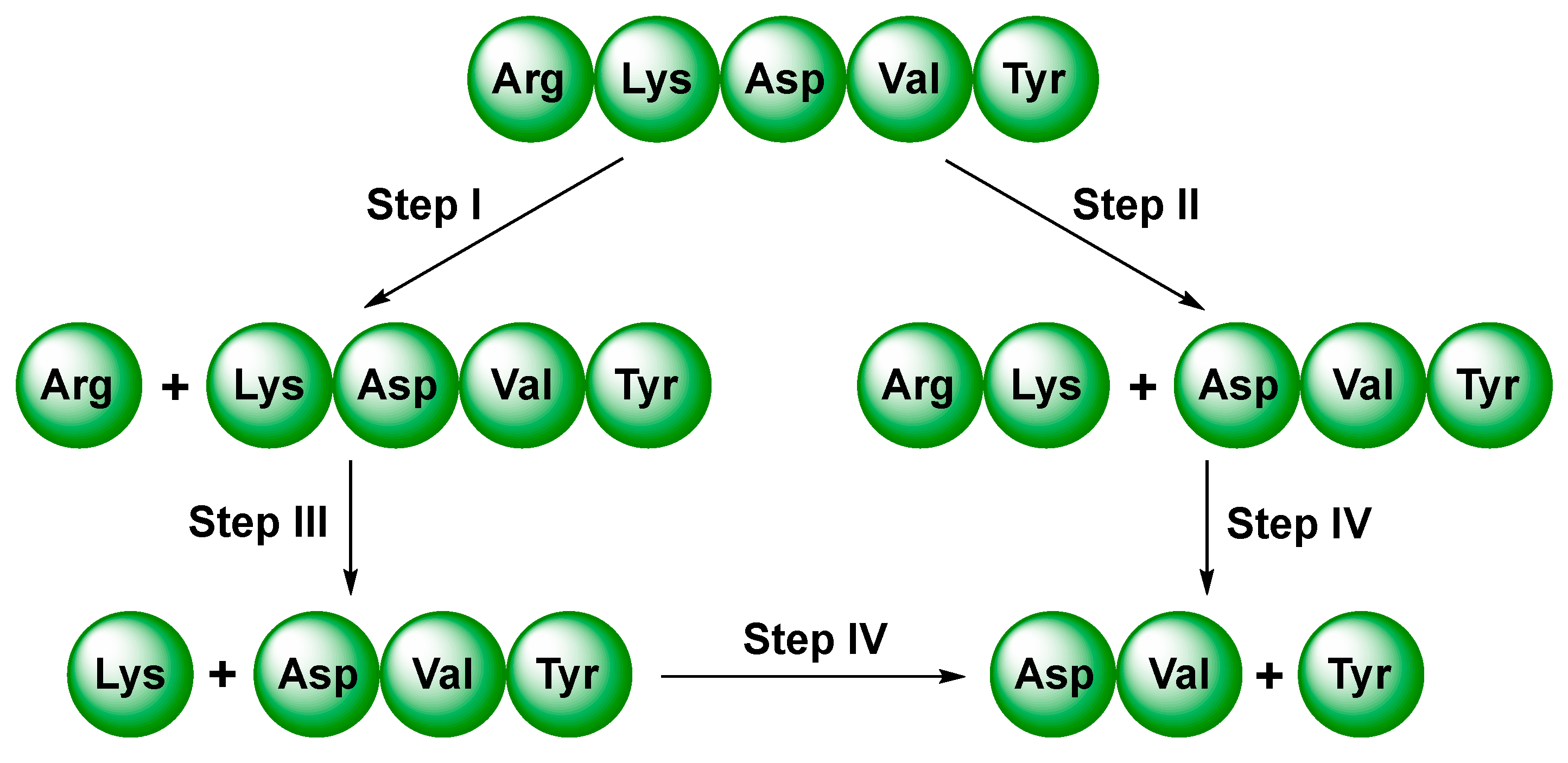
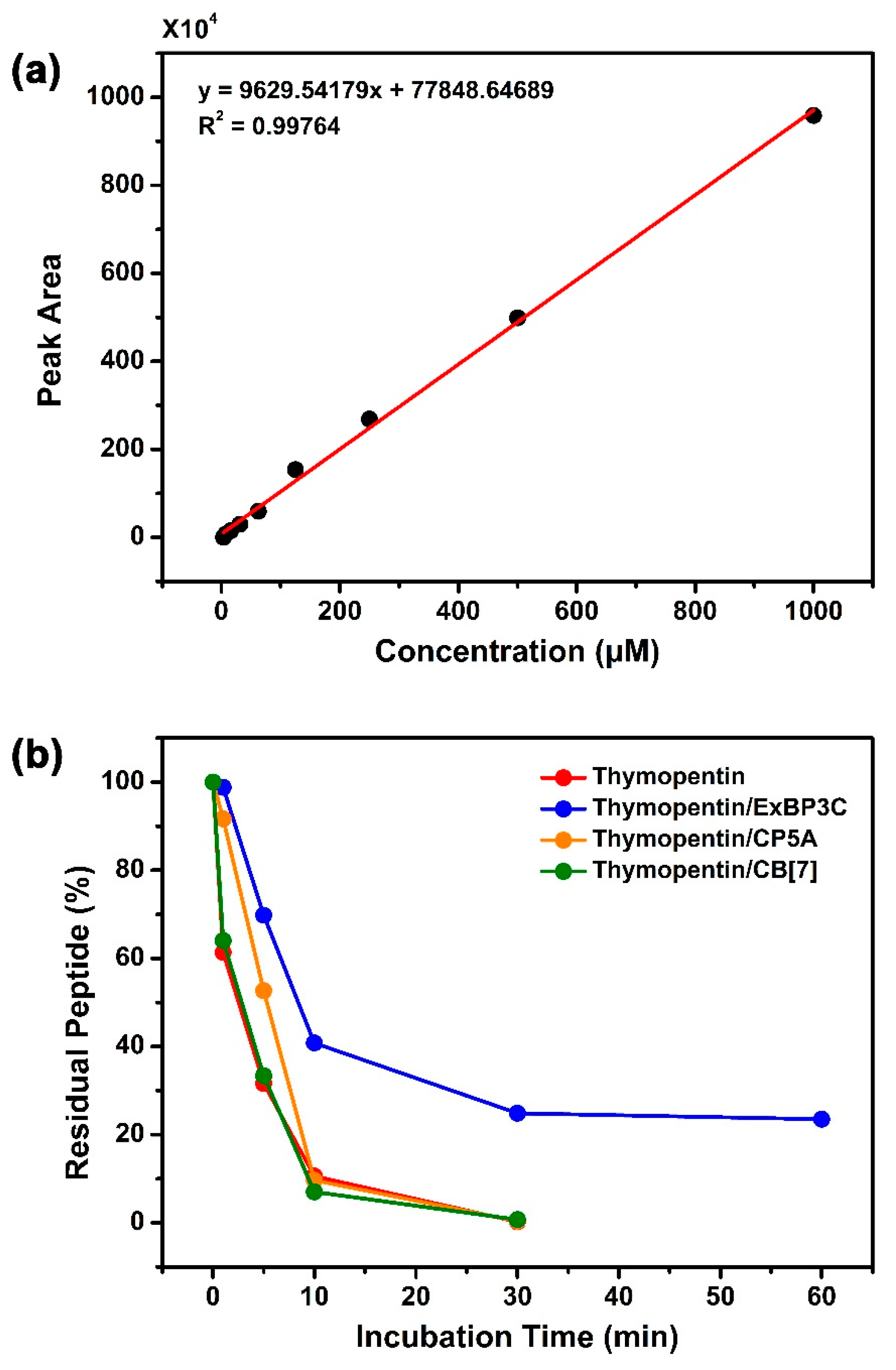
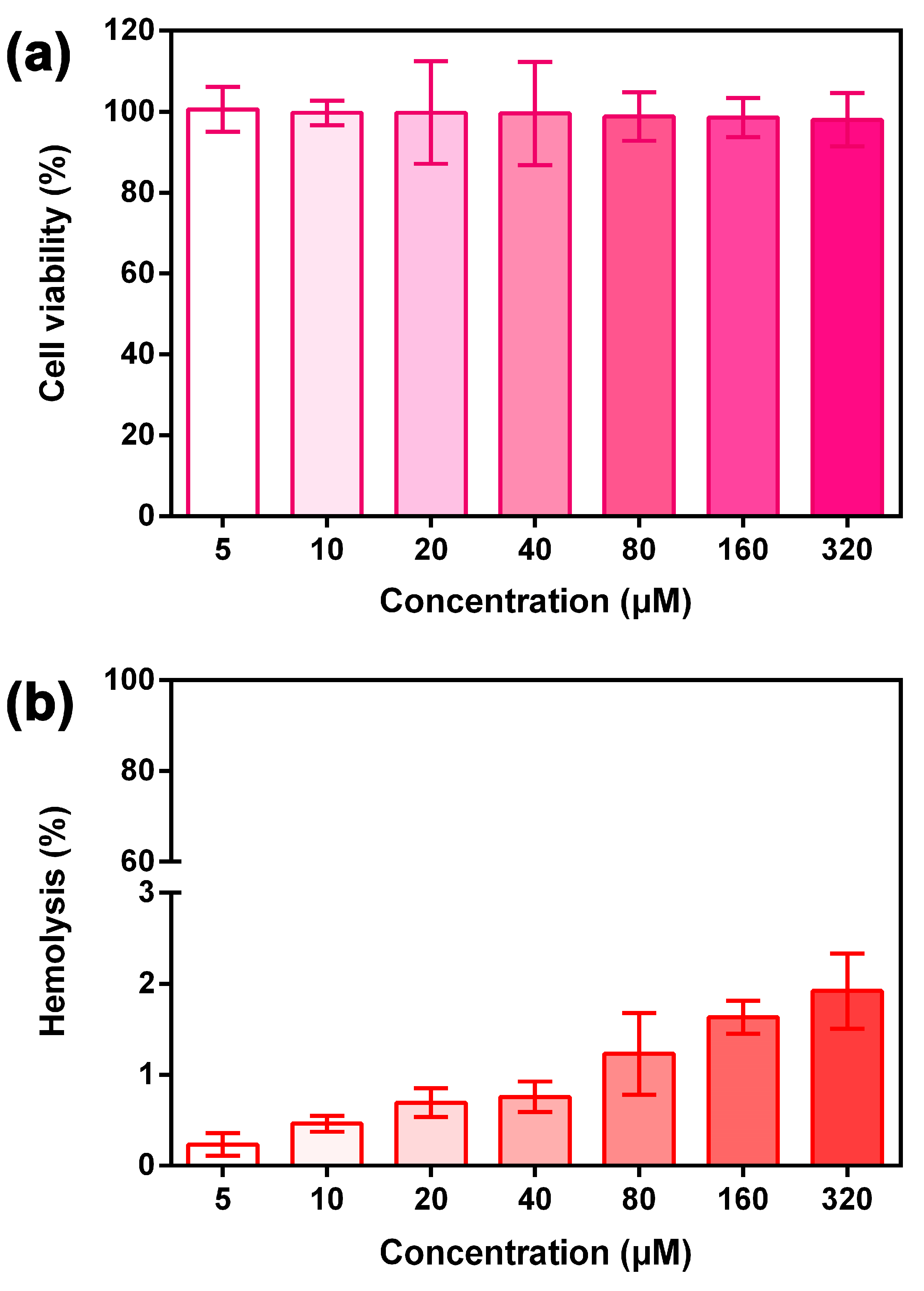
Disclaimer/Publisher’s Note: The statements, opinions and data contained in all publications are solely those of the individual author(s) and contributor(s) and not of MDPI and/or the editor(s). MDPI and/or the editor(s) disclaim responsibility for any injury to people or property resulting from any ideas, methods, instructions or products referred to in the content. |
© 2025 by the authors. Licensee MDPI, Basel, Switzerland. This article is an open access article distributed under the terms and conditions of the Creative Commons Attribution (CC BY) license (https://creativecommons.org/licenses/by/4.0/).
Share and Cite
Ren, K.; Chen, J.; Li, C. Entire Encapsulation of Thymopentin by Extended Biphen[3]arene Carboxylate for Improving Plasma Stability. Molecules 2025, 30, 314. https://doi.org/10.3390/molecules30020314
Ren K, Chen J, Li C. Entire Encapsulation of Thymopentin by Extended Biphen[3]arene Carboxylate for Improving Plasma Stability. Molecules. 2025; 30(2):314. https://doi.org/10.3390/molecules30020314
Chicago/Turabian StyleRen, Keming, Junyi Chen, and Chunju Li. 2025. "Entire Encapsulation of Thymopentin by Extended Biphen[3]arene Carboxylate for Improving Plasma Stability" Molecules 30, no. 2: 314. https://doi.org/10.3390/molecules30020314
APA StyleRen, K., Chen, J., & Li, C. (2025). Entire Encapsulation of Thymopentin by Extended Biphen[3]arene Carboxylate for Improving Plasma Stability. Molecules, 30(2), 314. https://doi.org/10.3390/molecules30020314




